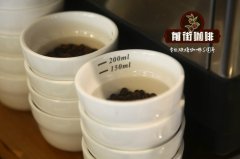Classification characteristics of Coffee varieties in Guatemala Flavor introduction to 8 Coffee producing areas in Guatemala
Professional coffee knowledge exchange more coffee bean information please follow the coffee workshop (Wechat official account cafe_style)
Guatemala is a big coffee producer in Central America, ranking eighth in the world in terms of output. Guatemala, whose name comes from the Mayan language, means "country of the forest", thelandofmanytrees. Located in Central America, it is known as "the pearl in the crown of China and the United States". Although Guatemala has a limited land area, it has a rich and diverse climate. A country famous for its lakes and volcanoes, with volcanic soil, precipitation, temperature, humidity and altitude, Guatemala has a natural environment suitable for coffee growth.
Classic Anti melon
Antigua Classic
Antigua is called a "classic" mainly because it is one of the oldest and most famous producing areas in Guatemala. Rich volcanic soil, low humidity, sufficient sunlight, large temperature difference between day and night, and so on are the classic characteristics of Antigua. The valley is surrounded by Agua, Acetenango and Fuego volcanoes. Among them, Fuego is one of the three most active volcanoes in Guatemala, which can provide a steady stream of volcanic ash and minerals for the soil of the region.
Of the coffee beans sold in Guatemala around the world, 18-200000 packets identify themselves as Antigua. But in fact, the annual output of pure Anti melon is no more than 80,000 packs. This means that only 30-40% of the Antigua in the global market are pure Antigua. As a result, Antigua produced in surrounding areas and even countries outside Guatemala will be identified as GENUINE, TYPE and ANTIGUA. Only the real Genuine Antigua is the real high-quality Antigua.
Altitude: 1500-1700 m
Soil: volcanic pumice
Main microclimate factors: closed valleys
Average annual precipitation: 800-1200 mm
Average temperature: 18-22 °C
Relative humidity: 65%
Main treatment: insolation
Shade species: Gravilea
Tree species: bourbon, Kaddura, Kaduai
Harvest season: January to mid-March
Akat Nango Valley
Acatenango Valley
The Alcatel Nango Valley (Acatenango Valley) is as high as 2000 meters above sea level, with dense shade and unique ecology. The nearby Tierra del Fuego volcano continues to erupt, making its coarse, sandy soil rich in a variety of substances. Temperate sea breezes from the Pacific and a seasonal climate allow coffee in this region to be dried by sunlight and processed according to traditional family methods that have been accumulated over the years. Akat Nanguo Valley coffee cup test characteristics: obvious acidity, dry and wet fragrance, pleasant, drunk thickness, clear and long aftertaste.
Altitude: 1500-2000 m
Soil: volcanic rocks and clay loam
Main microclimate influencing factors: Akernango Valley
Average annual precipitation: 4000-4500 mm
Average temperature: 16-20 ℃
Relative humidity: 70-80%
Main treatment method: washing
Shade species: Inga
Tree species: bourbon, Kaddura, Kaduai
Harvest season: December-March
Vivette Nango Highland
Highland Huehuetenango
Although there are many highlands in Guatemala, among the coffee producing areas, only Vivette Nanguo can be called Vivette Nanguo Highland. The region's Cuchumatanes mountains span several of the highest non-volcanic peaks in Central America and are the highest and driest non-volcanic area in Guatemala. The dry, hot land breeze from Mexico's Kuantepec Plain allows the coffee growing area in this area to be as high as 2000m above sea level.
Altitude: 1500-2000 m
Soil: limestone
Main microclimate influencing factors: Twanteppe Plain
Average annual precipitation: 1200-1400 mm
Average temperature: 20-24 °C
Relative humidity: 70-80%
Main treatment: insolation
Shade species: Inga
Tree species: bourbon, Kaddura, Kaduai
Harvest season: January-April
San Marcos, vol.
Volcanic San Marcos
San Marcos is known as the San Marcos volcano mainly because the area has far more volcanoes than any other coffee-growing area and is the hottest of the seven producing areas. It also has the most concentrated tropical rain forest, as well as the most concentrated rainy season and the earliest flowering.
Altitude: 1400-1800 m
Soil: volcano
Main microclimate influencing factors: Pacific Ocean
Average annual precipitation: 4000-5000 mm
Average temperature: 21-27 °C
Relative humidity: 70-80%
Main treatment: insolation
Shade species: Inga
Tree species: bourbon, Kaddura, Kaduai
Harvest: December-March of the following year
Traditional Atitlan
Traditional Atitlan
80% of the traditional Attland comes from small plantations or coffee farmers, mostly Mayans. The word "tradition" mainly reflects the characteristics of traditional manual picking in the region. Among the four volcanic regions, the traditional Attland is the one with the most abundant organic elements in the soil. 90% of the traditional Attland is grown on the slopes of volcanoes, and the water source comes from Lake Attilan, the most famous lake in Guatemala.
Altitude: 1500-1700 m
Soil: volcanic soil
Main microclimate influencing factors: large volcanic lakes
Average annual precipitation: 1800-2300 mm
Average temperature: 20-23 °C
Relative humidity: 75-85%
Main treatment: insolation
Shade species: Gravilea & Inga
Tree species: bourbon, Tibica, Kaddura, Kaduai
Harvest season: December-March
Koban rain forest
Rainforest Coban
The word Koban Coban comes from the Mayan language "Cob" (source of wind). The biggest feature of the region is the rainforest, which is accompanied by high humidity and abundant nutrients. What distinguishes Koban from other coffee-growing areas in Guatemala is that it is cloudy, rainy and cool all the year round. The soil is formed in limestone and clay. The cultivation of the Koban rainforest depends on the continuous hills and is deeply influenced by the Atlantic Bay and the northern jungle.
Altitude: 1300-1500 m
Soil: limestone & clay
Main microclimatic factors: Atlantic Ocean
Average annual precipitation: 3000-4000 mm
Average temperature: 15-20 °C
Relative humidity: 85-95%
Main treatment: insolation
Shade species: Inga
Tree species: bourbon, Kaddura, Marago Gippe, Kaduai, Pach
Harvest: December-March of the following year
Farrakhan Nice Plateau
Plateau Fraijanes
This area is very high above sea level, but at the same time it is open and rugged, and it is difficult for people in the deep area to realize that they are in the middle of the plateau. At the same time, it is also the core area of the national geography. Along with Antigua, it is known as the oldest coffee growing area in Guatemala. Volcanic soil is filled with pumice, extremely high elevations, and active volcanoes-these are the most important features of the Farrakhan Nice Plateau.
Altitude: 1400-1800 m
Soil: volcanic pumice
Main influencing factors of microclimate: plateau
Average annual precipitation: 1500-3000 mm
Average temperature: 12-26 °C
Relative humidity: 70-90%
Main treatment: insolation
Shade species: Inga
Tree species: bourbon, Kaddura, Kaduai, Pach
Harvest: December-February of the following year
New Oriental
New Oriente
This area is called the East because it is the easternmost region of Guatemala. The "new" stems from the fact that it is the most emerging producing area in Guatemala and is full of explosive power at the same time. The rainy and foggy characteristics make it somewhat close to the Koban rainforest. Located in the volcanic belt of the past, most of the soil comes from metamorphic rocks. All this makes the soil mineral balance in this area, which is far different from other volcanic areas in Guatemala. It had all these high-quality features before it was used as a coffee growing area.
Altitude: 1500-1700 m
Soil: metamorphic rock and clay
Main microclimatic factors: Atlantic Ocean
Average annual precipitation: 1800-2000 mm
Average temperature: 18-25 °C
Relative humidity: 70-80%
Main treatment: insolation
Shade species: Inga
Tree species: bourbon, Kaddura, Kaduai, Pach
Harvest: December-March of the following year

End
Important Notice :
前街咖啡 FrontStreet Coffee has moved to new addredd:
FrontStreet Coffee Address: 315,Donghua East Road,GuangZhou
Tel:020 38364473
- Prev

The flavor characteristics of Guatemalan coffee and the flavor description of Guatemala la Minita flower god
Professional coffee knowledge exchange more coffee bean information please follow the coffee workshop (Wechat official account cafe_style) Guatemala is a major coffee producer in Central America, ranking eighth in the world in terms of coffee production. Guatemala, whose name comes from the Mayan language, means thelandofmanytrees, the country of the forest. Located in Central America, it is known as the pearl in the crown of China and the United States. Although the territory of Guatemala
- Next

Flavor characteristics of Honduran Coffee and description of Coffee Flavor in Honduras Sweet Orange Manor
Professional coffee knowledge exchange more coffee bean information please follow the coffee workshop (Wechat official account cafe_style) Honduras (Honduras) well-known representative coffee: Honduran coffee seems strange to many coffee drinkers. For coffee production, Honduras
Related
- Detailed explanation of Jadeite planting Land in Panamanian Jadeite Manor introduction to the grading system of Jadeite competitive bidding, Red bid, Green bid and Rose Summer
- Story of Coffee planting in Brenka region of Costa Rica Stonehenge Manor anaerobic heavy honey treatment of flavor mouth
- What's on the barrel of Blue Mountain Coffee beans?
- Can American coffee also pull flowers? How to use hot American style to pull out a good-looking pattern?
- Can you make a cold extract with coffee beans? What is the right proportion for cold-extracted coffee formula?
- Indonesian PWN Gold Mandrine Coffee Origin Features Flavor How to Chong? Mandolin coffee is American.
- A brief introduction to the flavor characteristics of Brazilian yellow bourbon coffee beans
- What is the effect of different water quality on the flavor of cold-extracted coffee? What kind of water is best for brewing coffee?
- Why do you think of Rose Summer whenever you mention Panamanian coffee?
- Introduction to the characteristics of authentic blue mountain coffee bean producing areas? What is the CIB Coffee Authority in Jamaica?

